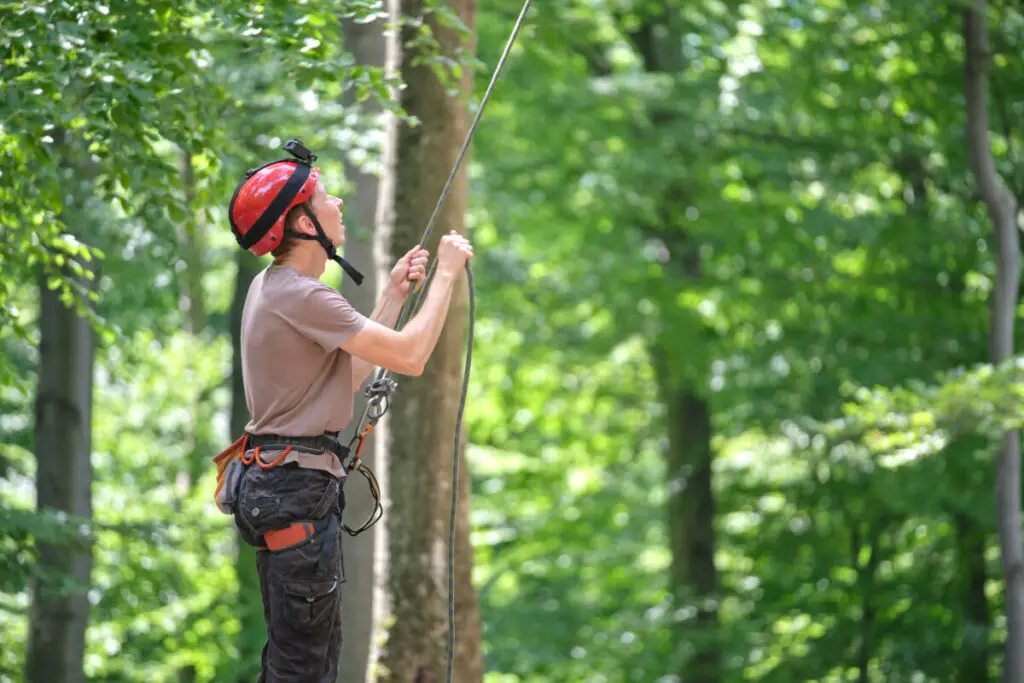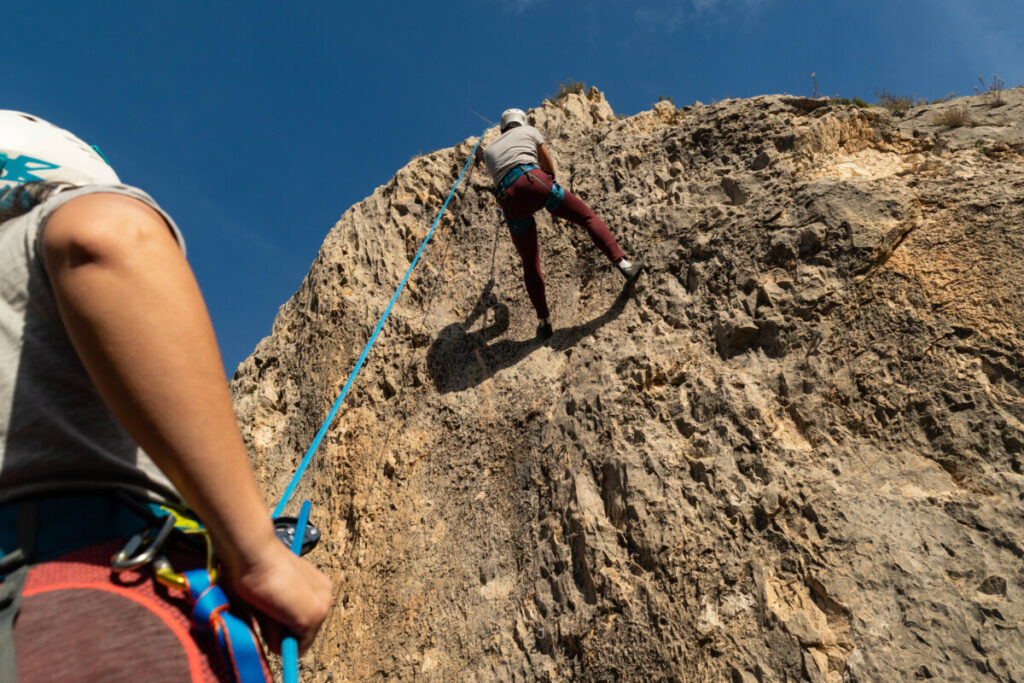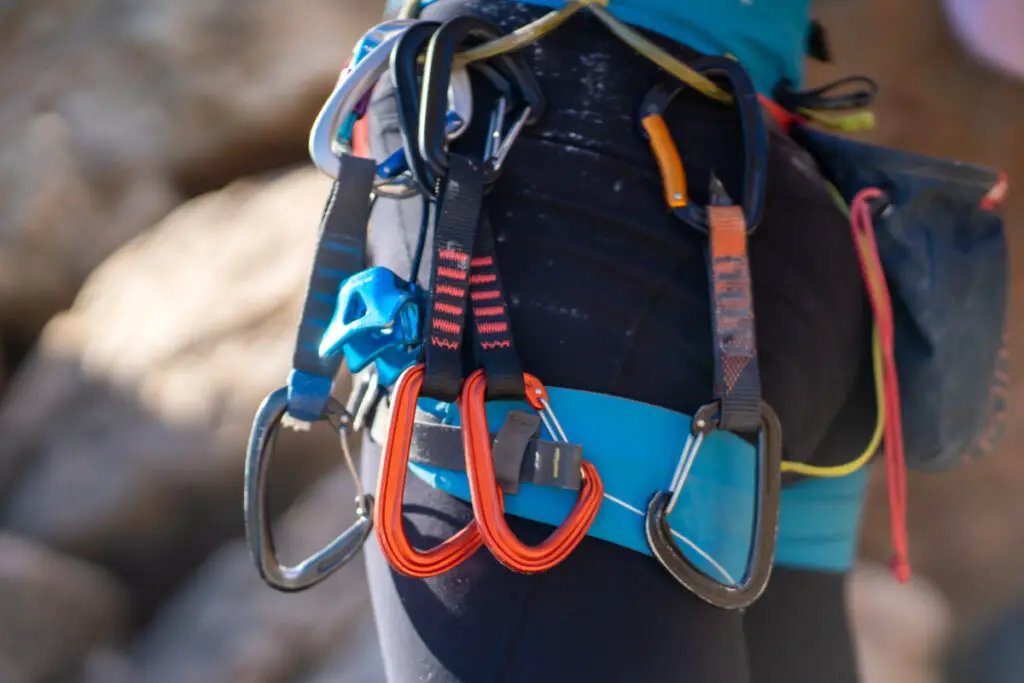
Safety is the main harmony that is hummed through the art of rock climbing. Having safety is such a matter is going to ensure you are enjoying what you’re doing instead of worrying about how much you can hum at all.
The minimum a belayer can weigh is 70% of the lead climber. So, if the lead weighs 175 lbs, the belayer should weigh no less than 123 lbs. However, the more a belayer weighs, the safer the lead will be. Because the belayer acts as a counterweight it’s ideal for it to weigh as much as the lead.
The difference in weight will depend greatly on the experience of both climbers and the equipment being used. Make sure you understand your circumstances to make sure everyone involved is going to be safe.
Does the Weight of the Belayer Matter?
Because belayers need to weigh more than the climber to keep them safe and to counteract their weight, the weight of the belayer matters. However, there are things that you can do to make the weight of the belayer not necessarily important.
Weighing less than your climbing partner is not the greatest problem to overcome if the belayer knows how to properly keep the climber safe should anything bad happen. Some belayers that weigh 50 lbs less than their climbing partner could be 100 times safer than an inexperienced belayer who weighs 50 lbs more than the climber.
If you don’t know what you are doing as a belayer, please make sure you weigh more than the climber and take extra precautions. If you do know what you’re doing, there are things that you can do so you can basically disregard weight altogether.
Why 70%?
Because the weight difference varies so much based on many factors, giving a precise number is not very meaningful or helpful. However, there are some things that you should keep in mind. For example, belaying someone that weighs 3 times as much as you is not smart or safe. If you weigh more than them, then there should be no problems when it comes to counterbalancing them.
After researching and talking to people who are experienced rock climbers, it was clear that most of them weren’t comfortable or willing to be a belayer for someone who weighs more than about 50 lbs more than them or be belayed by someone who weighs significantly less than them. A person weighing 100 lbs is probably not going to be comfortable being belayed by someone that weighs 50 lbs.
If you use a percentage to determine if you can or should be the belayer for someone, then you don’t have to worry about whether or not the climber will get hurt because you didn’t weigh enough to counterbalance them properly. Using numbers gathered through research, 70% is a good estimate that should work a majority of the time for the majority of climbers.
Still though, weighing 70% of the climber is a minimum. With rock climbing, risking the safety of the climber and belayer by not figuring out if one is the correct weight to counterbalance the other is not recommended. If you want to take risks while rock climbing, there are much better ways to do so. Don’t try to rock climb with an unsound belayer.
Experience

So, here’s the skinny. Being the belayer means holding a lot of responsibility. If you’re a novice at rock climbing, you probably want to weigh more than the lead in order to make things easier on yourself. However, plenty of experienced rock climbers are able to skillfully deal with climbers that weigh significantly more than them. So, just knowing a general rule of 30% difference is not enough to ensure everyone is in a safe position while rock climbing.
So, what are the advantages of experience that give rise to safety? Mostly, it lies in expectations.
An experienced rock climber knows what to expect in belaying in terms of slack, tension, and braking. Someone who has belayed many times may be able to handle someone weighing 50 lbs more, while a novice should definitely avoid something like that.
Am experienced climber also knows what to expect if a climber falls. This is the main reason why belayers exist.
Since a belayer is a counterweight to the climber, we can turn to a bit of physics to shed some light. If the two climbers weigh the same amount, in theory they should completely cancel out any extra force, allowing the climber to remain suspended if they fall. This is clearly where weighing less than your climbing partner will be a problem.
You can expect a tug from the rope that is connected to your harness if your rock climbing partner falls. If you weigh less than your partner, the tug pulling up on you will be greater than gravity pulling down on you. In layman’s terms: you’re going to shoot upwards, which will be absolutely terrifying.
An experienced climber can manage this tug. Performing a “soft catch” is what you need to do. It is important for every rock climber to be able to perform a soft catch, but doing this with perfection is what is required when belaying someone heavier than you.
Safer Solutions
If you have no rock climbing skills, your weight will essentially be your only friend in making sure your climbing partner doesn’t fall and become seriously injured. In order to be a responsible belayer, it is important to add some tools to your belt. The last thing you want is to be belaying on the ground with your climbing partner on the rock face, and then moments later be in the reverse position.
More weight

A common practice in both outdoor and indoor rock climbing is to add more weight. How much weight to add depends, again, on the weight difference between you and your climbing partner. Adding weight is more common and practical at an indoor facility, but it is still possible outside.
One option is to tie weight directly to your harness. This could include weights used for lifting or something as janky as a bag of rocks. A similar option is to wear a backpack full of weights.
The problem with adding weight to yourself is it can be awkward and uncomfortable. If you are belaying you probably want to be as in control as you can, and adding weight to yourself goes against that notion. It will also likely cause your back to hurt quite quickly. However, it is an option.
Something that is more common and advanced that you can do is anchor yourself. It is exactly as it sounds and entails you tying yourself down to something that is heavy and stationary. Anchors can be attached to the ground or an object as funny as a boat bumper filled with water. It just needs to be so heavy that the climber’s weight can’t lift it.
If you anchor yourself down, it no longer matters how much you weigh. If you are unsure if you weigh enough to belay someone, anchoring yourself down will ensure that you won’t go flying if the rock climber falls as long as the knot in the rope tying you to the object is tied tightly.
One of the most simple solutions that you can implement is to just have a second belayer. A second belayer literally just acts as more weight to counterbalance the rock climber, as they are connected to the first belayer. They are as important as the first belayers and need to be just as attentive.
In theory, you can just keep adding belayers if you need more weight, but this starts getting dangerous and is impractical. It is not worth it to have 10 kids all holding on to each other in order to be a counterweight.
The Edelrid Ohm
If you weigh less than the rock climber and are a belayer, there are things that you can use to make it easier to do so, including an Eldelrid Ohm. The Edelrid Ohm is a small device about the size of a carabiner and exists in order to help belayers who weigh less than the climber they are supporting. It is a braking resistor that can help reduce the distance a climber will drop if they lose their grip. It is attached to the first bolted anchor of a route and has been tested extensively.
The device works by adding resistance in the form of friction during a fall. The rope passes through the device easily during the normal climbing process, but if the climber falls, the orientation of the Edelrid Ohm changes by about 90 degrees and ensures the climber can’t fall beyond the length of rope up to the first bolted anchor.
So, the problem is that it doesn’t necessarily provide a smooth descent as you would get from lowering the person yourself with the proper weight and technique. Instead, it is more like a cut-off point that makes sure they can’t fall all the way down. The climber could experience a “hard” or “dynamic” fall, which means their fall isn’t very controlled and can end in them hitting the climbing surface, which will likely cause injuries. But, at least they won’t hit the ground!
There is plenty more to explore about the Edelrid Ohm and there has also been plenty of reviews online. Check them out to find out more and see if this is the solution for you.
Stance
A lot is going to rely on your stance and how you position yourself when you are a belayer. You could be the most alert and quick-reflexed belayer, but none of that is going to matter if you are not in a proper stance and position.
Firstly make sure you know the surroundings. Know where the sharp rocks are and where the best footing is. Know where the best footing is if you get jolted. Also, know where you could hit the wall and make sure it isn’t any worse than everything else around.
Another good tip is to make sure you stand close to the wall, but not directly below the climber. It can be strenuous to be close to the wall because looking up for a long time will not be fun. It’s worse than sitting in the front row at a movie theater. However, try to avoid moving away from the wall.
The further you move back from the wall, the less your weight can contribute to being a counterweight for the climber. If your climbing partner falls, they need a force pointing straight down to counter their scary descent, but if you are far back from the wall, a portion of the force from the falling climber that is traveling through the rope will be directed in pulling you forward instead of up. Not only are you being a relatively bad counterweight, but you also have a much higher chance of being slammed into the wall.
Practice First

Whatever methods you have chosen to employ to compensate for the difference in weight, take it to a climbing gym first and practice. Baptism by fire isn’t really what you want to go for here.
It can be extremely easy to dive into something that is only slightly different from what you’re familiar with, but in this case, experience can be very valuable so you can better anticipate what is going to happen and prepare for worst-case scenarios.
Make sure both people know exactly what to expect and what is going to happen when you go rock climbing as a climber or belayer. Do a planned fall and try different methods to see what is best for everyone. Try adding weight or anchoring the belayer to see if the results are better when the rock climber falls.
Be Safe
Hopefully, you have picked up a theme of safety throughout this article. If you’re a rock climber, I am willing to bet it’s already a theme in your rock climbing life. But, as a final reminder: always err on the side of caution and safety, or you might regret it.

